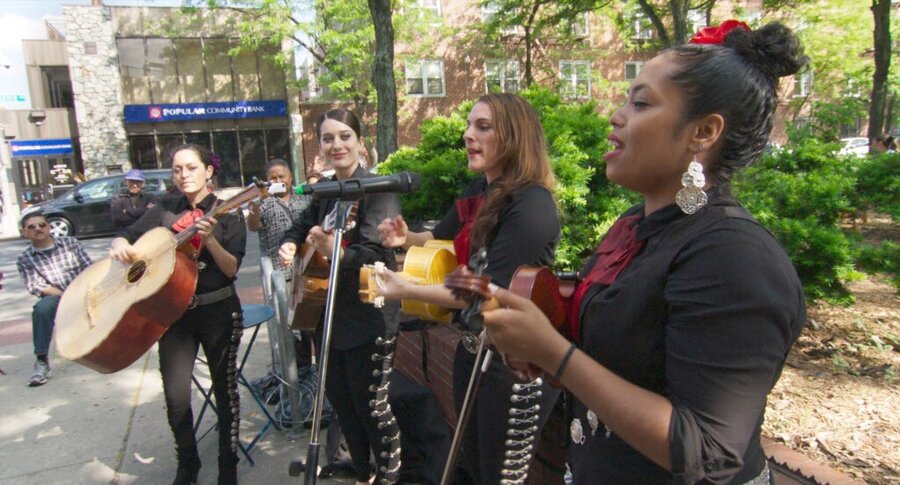'In Jackson Heights' is a marvelous look at the clash and glory of human diversity
Loading...
“In Jackson Heights,” Frederick Wiseman’s marvelous new documentary, is nominally about the famously multiethnic neighborhood in Queens, New York, but, like almost all of Wiseman’s work, its ostensible subject is only a starting point. What the film is really about is the clash and glory of human diversity.
Wiseman and his regular cinematographer, John Davey, filmed in Jackson Heights over nine weeks in the summer of 2014. What they show us is so voluptuously various that at times you have to remind yourself that you are watching a movie set in America. We see Hindu and Islamic religious rites, assemblages of Latino immigrants, a halal butcher shop, Asian children at play, and much else. At least half of the film is in Spanish, with English subtitles.
At first all this seems exotic, but not long into this more-than-three-hour movie the rough-edged patchwork begins to coalesce into a crazy quilt of seamless variety. Wiseman’s movies work on you by the slow accretion of detail. He may be overly fond of filming talking head community planning sessions, but what he is trying to do is anatomize the process by which people attempt to survive.
He’s one of the few filmmakers, documentarian or otherwise, who is voraciously interested in how people live their lives. The moments that, for most other filmmakers, would be rendered as fleeting – the stares and sidelong glances, the way people carry themselves when they are scared or wary or proud – are, for him, flashpoints of epiphany. His shape-shifty artistry allows him to enter in any situation and allow its revelations to take hold, without utilizing any voice-over narration or direct-camera interviews.
The film unfolds for us as a glorious farrago, with the intonations of the city as disparate as its landscapes, but the makeshift quality is an illusion. Wiseman, who edits his own movies, has a novelistic way of layering the narrative. Among modern documentarians, he’s the great realist, and yet his movies go beyond realism. They are not “objective” artifacts. Behind each of them is Wiseman’s capacious, unblinking sensibility. Somehow, the Jackson Heights of this movie is both a real neighborhood and a fantasia.
Scene after scene in “In Jackson Heights” hits home. On her way to the hospital to visit her dying father, a woman randomly encounters a group of evangelical women on the street corner and forms with them an impromptu prayer circle. A 98-year-old Jewish woman, socializing with some companions in a rest home, is hectored by one of them to reveal her “secret” for longevity. She shrugs it off, but in the same breath she opens up about her loneliness, about how she was happy until her husband died. In a meeting of mostly undocumented immigrants, a woman describes the ordeal of her daughter attempting to cross into America, and the words come pouring out of her. She is fiercely eloquent, and when her testimony ends she sits down, almost apologetically, as if she had momentarily been possessed by a force beyond her reckoning.
A New York councilman offers praise to a meeting hall of listeners and soon, chuckling at his dilemma, finds himself ticking off a stream of the nationalities in the neighborhood, from Central American to Far East Asian, hoping to leave no one out. You can sympathize with him: 167 languages are spoken in Jackson Heights.
The impending gentrification of the neighborhood is the omnipresent area of concern in this film. So is the mistreatment and recognition of the burgeoning lesbian, gay, bisexual, and transgender community. Wiseman films the gay and transgender activists on parade, and in workshops, planning sessions, and discos, and his steady gaze is like an embrace. (As a visual artist, Wiseman is the opposite of, say, Diane Arbus, who transformed her people into creepy oddities.) Wiseman and Davey have an unerring eye for faces: In the audience at an outdoor concert, we see a whole host of them – young, old, enraged, spooked, placid – and each is like an emblem of experience.
The comedy that arises in “In Jackson Heights” is the human comedy, and deeply funny because of it. After much haggling, a counselor instructs a group of immigrants applying for US citizenship to answer why they want to become Americans by simply responding, “I want to vote.” The coach of a polyglot class of would-be taxi drivers devises a mnemonic system for getting around the city that involves memorizing a particular bodily function. His patter is as jet-propelled as a Vegas comic’s, while his charges, doubly dumbfounded, gape at the blackboard. (Wiseman must have thought he’d died and gone to heaven when he trained his camera on this scene.)
In lesser hands, “In Jackson Heights” might have come across as a portrait of a “social experiment.” Given the current overheated atmosphere of politicized debate about immigration in America, the film is, of course, timely, but it’s a great deal more than that. It’s timeless. Grade: A (Unrated.)







